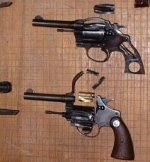3006loader
New member
Why are cartridges rated to a maximum pressure if the main thing you should worry about from loading over max charge is the gun blowing up? Shouldn't the guns themselves be rated for that pressure? Can you go slightly over a maximum pressure for a given cartridge as long as the gun can handle it? Or are all guns rated to the maximum pressure of the cartridge they fire?
An Example: .38 special is rated to 17000 PSI. If I have a gun that shoots both .38 special and .357 magnum (35,000 PSI max.), then could I load the .38 Special to around 25,000 PSI and still have it be safe, or does something happen specifically to the brass in over pressure situations?
I know reloading can be dangerous so I will always stay in the recommended loads (I like my guns), but was just curious about this.
An Example: .38 special is rated to 17000 PSI. If I have a gun that shoots both .38 special and .357 magnum (35,000 PSI max.), then could I load the .38 Special to around 25,000 PSI and still have it be safe, or does something happen specifically to the brass in over pressure situations?
I know reloading can be dangerous so I will always stay in the recommended loads (I like my guns), but was just curious about this.

